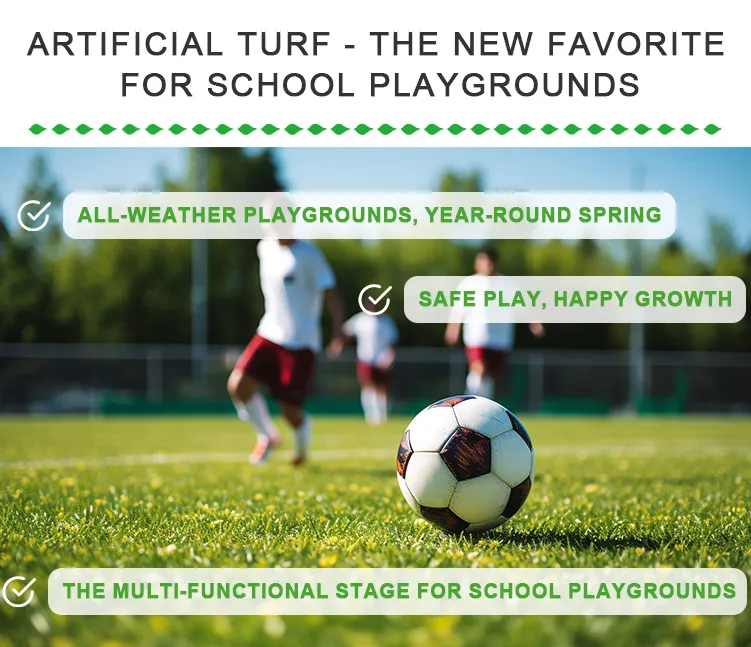
- Afrikaans
- Arabic
- Belarusian
- Bengali
- Czech
- Danish
- Dutch
- English
- Esperanto
- Estonian
- Finnish
- French
- German
- Greek
- Hindi
- Hungarian
- Icelandic
- Indonesian
- irish
- Italian
- Japanese
- kazakh
- Rwandese
- Korean
- Kyrgyz
- Lao
- Latin
- Latvian
- Malay
- Mongolian
- Myanmar
- Norwegian
- Persian
- Polish
- Portuguese
- Romanian
- Russian
- Serbian
- Spanish
- Swedish
- Tagalog
- Tajik
- Thai
- Turkish
- Turkmen
- Ukrainian
- Urdu
- Uighur
- Uzbek
- Vietnamese
Artificial Turf Options for Soccer Fields to Enhance Playability and Durability
Nov . 05, 2024 23:10 Back to list
The Advantages of Fake Grass for Soccer Fields
In the world of sports, the playing surface is of utmost importance. For soccer, a quality field can greatly influence the game—impacting player performance, safety, and competition standards. Traditional grass fields have long been the standard; however, the rise of fake grass, or artificial turf, has transformed the landscape of soccer fields. This article delves into the advantages of using fake grass for soccer fields and why it has become a preferred choice in various regions.
Consistent Playing Conditions
One of the most significant advantages of fake grass is the consistency it provides. Natural grass fields can become patchy and uneven due to wear and tear, especially in areas with heavy foot traffic. Weather conditions further complicate maintenance; rain can create muddy patches, while extreme heat can scorch the grass. Fake grass offers a uniform playing surface that remains consistent regardless of the weather. Players can rely on a stable performance without worrying about unexpected bumps or slippery patches, enhancing the overall quality of the game.
Durability and Longevity
Artificial turf is designed to endure intense use and adverse weather conditions, making it an ideal choice for busy soccer fields. Unlike natural grass, which requires regular reseeding, watering, and upkeep, fake grass maintains its integrity over time. It can withstand the wear and tear of frequent games and practices without the need for extensive maintenance. This durability translates to cost savings for schools, clubs, and municipalities, reducing the frequency and cost of field renovations.
Reduced Maintenance Needs
Maintaining natural grass soccer fields demands significant resources and labor. Regular mowing, watering, fertilizing, and pest control can be a daunting task, especially for large facilities. In contrast, fake grass requires minimal maintenance. Occasional brushing, infill replenishment, and washing to remove debris are typically all that is needed to keep the field in optimal condition. This reduction in maintenance not only saves time and labor costs but also allows facilities to allocate their budgets to other important areas, such as player development and equipment purchases.
fake grass for soccer field

Enhanced Safety
Player safety is paramount in any sporting environment, and the playing surface contributes significantly to the risk of injuries. Fake grass is engineered to provide better shock absorption and traction compared to natural grass. The infill materials used in artificial turf systems help minimize the impact during falls while providing a solid grip, reducing the chances of slipping injuries. With an even surface free of holes or divots, players can engage in the game confidently, knowing that their footing is stable.
Weather Resistance
Synthetic turf surfaces perform exceptionally well in various weather conditions. While natural grass may become unplayable during heavy rain, snow, or extreme heat, artificial grass can handle these challenges with ease. Rainwater drains through the infill layers, allowing for quick drying and resuming play shortly after adverse weather. This resilience ensures that teams can practice and compete on schedule, regardless of outside conditions, providing a clear advantage for programs aiming for consistency and reliability.
Environmental Considerations
Caring for natural grass often entails the use of fertilizers and pesticides that may harm the environment. In contrast, fake grass minimizes the need for such chemicals, promoting a more sustainable approach. Although the manufacturing of synthetic turf has its environmental impacts, advancements in technology are leading to more eco-friendly options, including recyclable materials and energy-efficient production methods. Many facilities are now choosing artificial grass because it contributes less negatively to the ecosystem over time.
Conclusion
With the many benefits of fake grass for soccer fields, including consistent playing conditions, durability, reduced maintenance needs, enhanced safety, weather resistance, and environmental considerations, it is no surprise that more clubs, schools, and municipalities are making the switch. As the popularity of soccer continues to grow globally, providing athletes with the best possible playing surface is crucial. Embracing artificial turf not only ensures a better game experience but also fosters a safer, more reliable environment for the development of future soccer stars. The evolution of soccer fields into fake grass surfaces represents a positive step forward in the realm of sports facilities.
-
The Benefits of Artificial Turf for Indoors
NewsJul.15,2025
-
How Artificial Grass Suppliers Ensure Quality Products
NewsJul.15,2025
-
Artificial Grass and Pets: A Space for Relaxation
NewsJul.08,2025
-
Balcony & Outdoor Decoration with Artificial Grass
NewsJul.08,2025
-
Best Indoor Artificial Grass for Home
NewsJul.07,2025
-
Best Pet Turf for Dogs: Safe & Durable Artificial Grass Options
NewsJul.07,2025
Products categories









